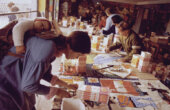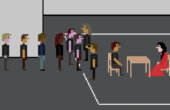Marcel Duchamp, the Gambler
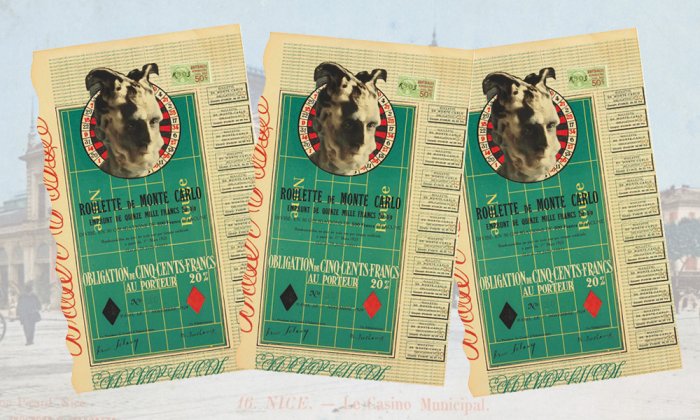
What was one of the most radical artists of the 20th century doing playing roulette in the casinos of Monte Carlo? And why did he insist, as he honed his complex gambling system, armed with capital from a risky financial scheme, that “I haven’t stopped being a painter, now I draw on chance”? This article is drawn from my book on the importance of the poet Stéphane Mallarmé for debates among European avant-garde artists about chance, the nature of language, and the hazards of communication. While the full chapter argues that Duchamp had Mallarmé’s impossible dream of “abolishing chance” in mind as he confronted the incipient financialization of art, this excerpt lays out Duchamp’s strategy to break the bank in Monte Carlo and his quixotic hope to render roulette into a game of chess.
“The system is being perfected. Enchanting and economical.”
— Marcel Duchamp to Pierre de Massot, December 1925
On November 1, 1924, Marcel Duchamp issued his Monte Carlo Bond, a limited-edition artwork and bearer bond (“obligation au porteur” as it is written on the front of the work), which is to say, a legal agreement that could be traded and spent like paper money.
As though advertising its split identity, the bond identified Duchamp’s female alter ego, Rrose Sélavy, as the “President of the Administrative Council” and relegated him to the role of her “Administrator.” The reverse of the bond provided the statues of Sélavy’s joint-stock company and some basic information about its aims: “The goal of the company is… Exploitation of Roulette in Monte Carlo under the conditions listed below… The annual payment is based upon a cumulative system [système à montant], experimentally tested through 100,000 rolls of the ball, which is exclusive property of the Administrative Council.”
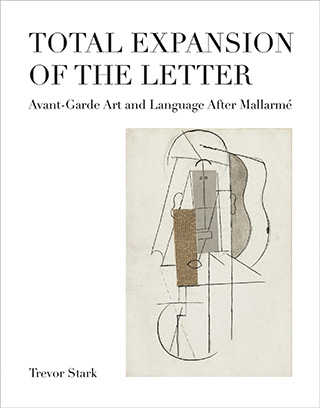
The stated purpose of its production and sale was to raise capital to fund Duchamp’s deployment of his roulette “system.” He initially intended to sell 30 Monte Carlo Bonds, but it seems that only eight were produced — and even fewer sold. The nature of the “sale,” what it meant to purchase one of the works, was one of its greatest paradoxes: On the one hand, it was a limited-edition print and artwork; on the other, it was made, quite seriously it seems, as a bearer bond, a financial instrument entitling its purchaser to be paid interest on their investment at a rate of 20 percent. These two modes entail radically different aesthetic, economic, and power relations between buyer and seller, yet they were fused in this one object, in which the artist was both source of aesthetic value and debtor, and the buyer was both collector and creditor. Whether conceived as a critique of the art market or as a shrewd financial arrangement, Duchamp’s Bond appears extraordinary prescient from the vantage point of the 21st century, when debt drives the financialization of social relations and works of art are sheltered from their public value (as objects made to be beheld or as taxable assets) in Freeport storage vaults, to be glimpsed only at the moment of exchange.
Whether conceived as a critique of the art market or as a shrewd financial arrangement, Duchamp’s Bond appears extraordinary prescient from the vantage point of the 21st century.
As with his intention to pay interest, Duchamp committed himself seriously to his roulette system, although the specifics have always been rather scant. The first mention of his interest in gambling systems comes from a trip in spring 1924 to Nice, where he was joined by Francis Picabia and Man Ray. Duchamp was in town for a chess tournament in early April and, while there, devoted himself to the antinomic activities of chess and gambling. As he wrote to the fashion designer and major collector of the avant-garde Jacques Doucet on March 31, 1924: “Outside of chess, I’m very occupied with 30 et 40. I’ve tried many systems and have lost like a novice. I’ve since gotten a bit of experience and am achieving some better results. I’m playing without betting [jouer à blanc] and hold my own very well.” He continued:
The best result is this= I’m not a gambler by any means_ I’m spending my afternoons in the gaming rooms and feel not the slightest temptation. Whatever I lost, I lost perfectly willingly_ and haven’t yet been smitten with gaming room “fever.” I find this whole way of life very entertaining and I’ll explain one of my systems to you when I get back.
“You can of course guess what this is all leading up to,” Duchamp concluded his letter to Doucet. “I really need the last 2000 F that you owe me.” Despite his assurance that he was “not a gambler,” Duchamp had evidently grown tired of absurdly playing roulette or the card game “30 et 40” “à blanc,” and sought to test his “system” with real capital.
Duchamp had to cope with the death of his parents in February, so it was not until June 1925 that he made it back to Monte Carlo. He stayed until September 11, armed with funds from selling his Bonds and buoyed by optimism, as he indicated to writer and friend Ettie Stettheimer: “I’ve been working for a year_ and my statistics give me a lot of confidence.” The artist, patron, and collector Katherine Dreier, for her part, having been informed of Duchamp’s project, offered to send him 5000 francs on condition that he “abandon his idea of Monte Carlo.” “Like a small child who doesn’t think,” she wrote, he was rushing headfirst into a risky situation, and despite the gorgeous weather in Monte Carlo, she worried that “the psychological atmosphere in such a place is bad for a person as sensitive as Marcel.”
What did Duchamp do in the casinos, and of what did these “statistics” consist? Writing to Picabia on April 17, 1924, he gave one of the fullest accounts of his activities:
With very little capital, I’ve been experimenting with my system for 5 days_ I’m regularly winning small sums every day_ in 1 hour or two_ I’m still perfecting it, and I expect to return to Paris with the system just right. It’s a delicious monotony. Without the least emotion. The problem actually lies in finding a red and black combination [figure] to play against the roulette wheel_ The Martingale is unimportant[.] They are all good and all bad_ But with the right combination_ even a bad Martingale can hold up. And I believe I’ve found the right combination_ As you can see, I haven’t stopped being a painter. Now I draw on chance.
Man Ray, who visited Duchamp in Nice and accompanied him to the casinos on at least one occasion, further recalled that Duchamp “studied the monthly sheets of all the numbers that came up, published by Monte Carlo, and worked out a system of placing his money that would infallibly bring in a return profit.” And, later, Duchamp specified that he was “exploiting a Martingale to break the bank in Monte Carlo,” but continued: “Unfortunately, the system is too slow to have a practical value. I often had to wait over half an hour for the numbers to appear in the succession of reds and blacks and the weeks I spent in Monte Carlo were so boring that I soon abandoned it, happy to emerge without a loss.”
“As you can see, I haven’t stopped being a painter. Now I draw on chance.”
From these documents, we can summarize a few known facts: first, that Duchamp studied the sheets of roulette numbers and colors published in magazines like La revue de Monte Carlo, journal scientifique and watched other players carefully; second, that he restricted himself to betting on even odds, which is to say red or black, even or odd, manque or passe, reducing roulette to a game of heads or tails; third, that he bet according to a preset pattern that he derived from his studies of published roulette statistics, sometimes requiring that he wait for long stretches at a time for the right order to come up (for example, waiting for five reds in a row before betting on black); fourth, that he would bet only small amounts; fifth, that his bets would follow a “martingale” system; sixth, that he ended by breaking even; and, seventh, that it was all quite boring — a “delicious monotony.”
To begin with the fifth point, the core of Duchamp’s system — and, indeed, of almost all betting systems — was the martingale strategy. The martingale is applicable to any game where the odds of winning or losing are even, and involves doubling one’s bets every time one loses, and betting only a single unit with every win. Therefore, facing a succession of losses, if one doesn’t lose one’s nerve, and continues to double the bets, just one win will be enough to recoup all the money lost. And, restricting oneself to betting only one unit after a win, the player avoids the “gaming room fever” for the methodical accumulation of profit. Assuming that one is playing a fair game, continually doubling one’s bets seems like a good strategy, since it rests on the high probability that neither win nor loss will predominate in a fair game over a large number of sessions, and that equilibrium will prevail.
Duchamp was far from the first to apply this seemingly sound logic to the gambling tables of Monte Carlo. He may have encountered the martingale in the memoirs of Giacomo Casanova, which Duchamp owned and evidently admired. Casanova, a notorious gambler, recalled visiting the casinos in Venice and experiencing a run of good luck: “I took all the gold I found, and playing the martingale, and doubling my stakes continuously, I won every day during the remainder of the carnival.” On another occasion, Casanova described his reversal of fortune: “I still played on the martingale, but with such bad luck that I was soon left without a sequin.” Yet he still held out for the emergence of the right “system”: “[Bankruptcy] must be the fate awaiting every man who has a taste for gambling, unless he should know how to fix fickle fortune by playing with a real advantage derived from calculation or from adroitness, which defies chance.”
The hope of “defying chance” at the roulette table through a martingale strategy was, in Duchamp’s time, common enough to be a subject of satire in the press. The author of detective stories Maurice DeKobra, for example, in an article published in Le Journal on December 27, 1925, titled “My Martingale,” described his system for winning roulette in strikingly similar terms:
Naturally, I have a martingale that allows me, with a fund of 12000 francs, to win 20 francs a day by playing for nine consecutive hours. You’ll tell me that this game isn’t very lucrative and that if I scrubbed floors, I’d earn 44 francs a day with a union wage. But I wouldn’t have the divine emotions that this small ball, capricious and fantastical, procures for me. I’ll generously share the secret of my martingale, if you feel like it.
His “infallible” martingale, which he kept written down in a notebook, sounds much like Duchamp’s and involved doubling down on losses and placing bets on even odds according to a predetermined pattern and only after a certain number of rolls. Even DeKobra’s sardonic comparison of gambling with waged labor echoed Duchamp’s description in a letter to his brother of his impassive deployment of the martingale as “a form of office work.”
For each such fantasy, however, there were more skeptical exposés of the rather shaky grounds for the martingale. The British inventor of the machine gun, Hiram S. Maxim, for example, published in 1904 his book “Monte Carlo Facts and Fallacies,” in which he described the martingale as “the least bad system that could be devised” for winning roulette. In this book, which Duchamp could very well have encountered in the course of his research on roulette systems, Maxim outlined a game plan similar to Duchamp’s: The player should restrict themselves to even odds (offering the smallest rewards but the highest chances of winning), bet small amounts (he suggests one louis [20 francs]), and follow the martingale by doubling on their losses in order to extract minor but dependable profits from a large number of séances.
Yet Maxim argued that several major flaws were built into the martingale system. First, if any player continually doubled their bets, a run of losses could easily bankrupt them without a significant amount of capital, or raise the stakes beyond the casino’s maximum allowed bet—a policy conceived precisely to dash the hopes of martingale devotees. Second, all statistical gambling systems are based on the false presumption that players are engaged in a fair game at all: In fact, all games in casinos such as those Duchamp visited are subject to a house advantage that ensures the casino’s profit, with the dealer in roulette collecting all players’ bets when the ball lands on zero.
Even setting aside the house advantage, the conviction that one could make strategic choices in betting — by waiting for a certain succession of reds and blacks before placing a bet, for example — inevitably falls prey to the so-called “gambler’s fallacy,” or “Monte Carlo Fallacy.” This error, common to many gambling systems, depends upon a false belief in the maturity of chances, in which the probability of red or black turning up on any given throw is assumed to change on the basis of past results. If, for example, the ball lands on red 10 times in a row, this would be statistically unlikely, but it does not mean that the following toss would be any more likely to be black than it was on the first: The probability remains 1/2 every time. Maxim’s text, for example, bore a cartoon of two gamblers discussing strategy. One exclaims that he had waited at the roulette tables all day until black had come up 10 times, and then bet 10 louis on red — and still lost. The other chastises him: “Foolish man … you should never bet against a color that is coming up,” and advises him to “follow the table” instead, that is to say, to recognize that each table has its own innate preferences, for red or black, for “runs” or “ jumpiness.” If this latter gambler explicitly invested roulette wheels with occult properties, any player who strategizes on even bets implicitly acts as though the roulette ball has a memory.
The martingale’s final and fatal flaw, for Maxim, might be called aesthetic. “Based strictly on the laws of chance and probability,” the system eliminated the source of pleasure for most gamblers: “It is too cold and unsympathetic for their aesthetic tastes.” Maxim continued:
If one wishes to play for the sake of play alone, if the play at Monte Carlo is considered a valuable kind of enjoyment, sufficiently valuable to be paid for … the doubling-up system of the Martingale is, without doubt, the worst possible system. … If, however, … we have but one end in view, and that to reduce the Bank’s chances to a minimum and to increase our chances of actually winning money from the Bank to a maximum, then the Martingale has a decided advantage over all other systems.
Maxim’s description of the martingale as an anti-aesthetic or anti-ludic strategy is key to Duchamp’s stated aims in these years. The mechanical dimension of the betting strategy, which Maxim described as an affront to most aesthetic sensibilities, seems to be exactly what Duchamp sought in Monte Carlo. He told Stettheimer before setting off to Monaco: “I’m going to play over there in this frame of mind: a mechanical mind against a machine. Nothing romantic about this business, no more than chance.”
Duchamp’s hopes of devising a “system” to “break the bank” and outwit chance resembled the delusions of any gambler who deployed the martingale — even in its resistance to play and passion. Duchamp’s activities differed in one crucial respect, however: At least after a time plying his system at the roulette tables, he proclaimed his interest in “wandering in equality” for its own sake, not only avoiding the “échauffement” (fever) of the average gambler, but seeking out a means to neutralize even the distinction between winning and losing. “Dabbling in equality,” Duchamp irrationally sought only to break even: “I’m neither ruined nor a millionaire, and will never be either,” as he wrote to Doucet.
Duchamp played at the roulette table with a pose of disinterest in the prospects of winning or losing, hoping in the end to achieve a “remarkable” “equality” between the two.
Gambling is based on the hope of “profiting without producing,” of being rewarded for the willingness to risk one amount of money by its multiplication as it passes through the medium of chance. Duchamp, conversely, played at the roulette table with a pose of disinterest in the prospects of winning or losing, hoping in the end to achieve a “remarkable” “equality” between the two.
Hubert Damisch sums up the paradox of the martingale: “It is the belief in the inevitable restoration of a final equilibrium from which the fantasy of the martingale derives; yet in practice one could hope to profit only from a long series of successes which would seem to defy any probable equilibrium.” Even further, one can methodically collect small gains or lose big by deploying the martingale, but the one option that it forecloses is neutrality: Any time a gambler hits upon a favorable outcome after doubling their bets, they will win back their losses with a supplement of one unit. It is strictly impossible to “break even,” as Duchamp claimed he did: One must be either a winner or a loser. Therefore, if Duchamp intended the martingale “to counteract chance … to treat it finally as an opponent, and roulette as a two-party game,” as Damisch puts it, so too did he seek to defeat the martingale’s built-in resistance to the zero sum, aiming for a perfect but impossible nullity.
In this respect, Duchamp seemed to have considered roulette as the dialectical counterpart to chess. As he put it to Doucet in a letter from January 16, 1925, “I believe I have eliminated the word chance_ I would like to think I have forced roulette to become a game of chess.” And, further, when Arturo Schwarz asked Duchamp about the relationship between chess, which depends on the mind, and gambling, which depends on chance, he responded: “In both cases it is a fight between two human beings, and by introducing more chance in chess and reducing the chance factor in gambling, the two activities could meet somehow.” This rather elliptical statement (who precisely is the second human being in roulette?) regarding the equalization of chess and gambling was given visual form in the poster he designed for the Third French Chess Tournament, held in Nice, about 20 kilometers from Monte Carlo, from September 2 to 11, where he was named Master of the Fédération Française des Échecs. For the poster, he placed cubes in a net, tossed them in the air, photographed the chance arrangement of blocks — like so many dice cast — traced them from the photograph, and placed the resulting chance arrangement within the outlines of a Staunton model King chess piece: chance contained and preserved, introjected into chess.
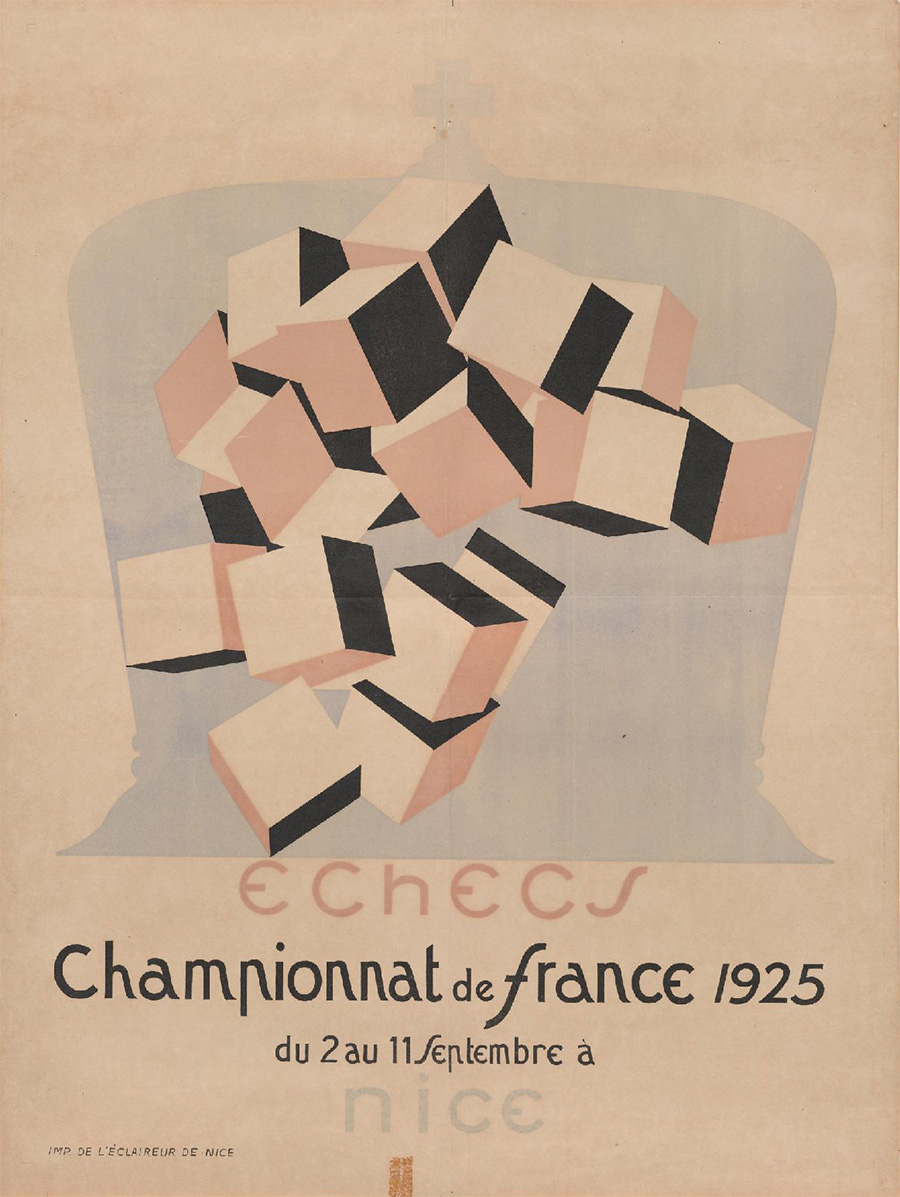
Yet it was perhaps in the anti-teleological desire to suspend the opposition between the win and the loss — rather than the antagonism between chance and control as such — where Duchamp’s martingale and chess experiments converged most precisely. A few years later, in 1932, he published a book with Vitaly Halberstadt on extremely unlikely chess scenarios, entitled “Opposition and Sister Squares are Reconciled by Duchamp et Halberstadt.” Proving the “existence of new forms of heterodox opposition,” the book ran through a series of endgames that fulfilled two rare conditions: First, only a few pawns and two kings must remain; and, second, the pawns must be blocked so that only the kings can move. Constrained in this way, Duchamp and Halberstadt explored the possibilities of what Henri-Pierre Roché described as a “haughty junket of the kings.” Refreshingly free of the dense technical language of the book, Roché summed up the stakes of this “heterodox opposition”:
Only sometimes the King has a choice between two moves and may act in such a way as to suggest he has completely lost interest in winning the game. Then the other King, if he too is a true sovereign, can give the appearance of being even less interested, and so on. Thus the two monarchs can waltz carelessly one by one across the board as though they weren’t at all engaged in mortal combat.
The goal of winning and the threat of losing are thus suspended in favor of a potentially infinite performance of “sovereign” indifference. Duchamp would later claim about this book that “Even the chess champions don’t read the book, since the problem it poses really only comes up once in a lifetime. They’re endgame problems of possible games but so rare as to be nearly Utopian.” The utopian character of these “neither common nor utilitarian” situations was secured by the rigorous suspension of the game’s end, which allowed the kings to play at haughty disinterest just as Duchamp “wandered in equality” at the roulette tables.
In 1937, the French literary critic and sociologist Roger Caillois reviewed Duchamp’s chess book, and insisted further on its anti-competitive dimension:
The only important thing to note is that these intellectual adventures are situated in a domain that absolutely eliminates the psychological element that is implied in the agonistic nature of the game. … Winning or losing cease to signify victory or defeat but are only contrary signs, equivalent and interchangeable.
Caillois, in this way, revealed the link between the martingale and the heterodox endgame: the attempted statistical abolition of chance at the roulette table and the working through of impossibly complex situations in chess are both ways of negating the psychology of play and its “agonistic” dimension. “Winning” and “losing” are drained of their meaning and radically “equalized.” At the roulette table, and later in the waltz of the kings, Duchamp imagined a kind of “utopian” activity that was totally indifferent to ends, and aspired only to a kind of “equality” or “neutrality identical to the void,” to put it in Stéphane Mallarmé’s terms.
Trevor Stark is Associate Professor of Art History in the Department of Art and Art History at the University of Calgary. He is the author of “Total Expansion of the Letter Avant-Garde Art and Language After Mallarmé,” from which this article is excerpted.

